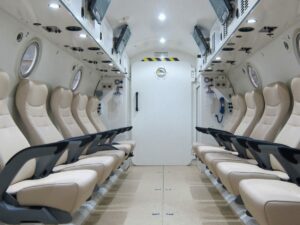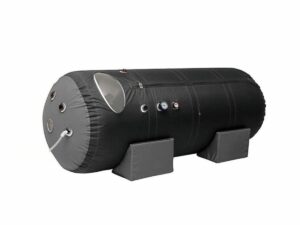Considering the expansion of hyperbaric therapy applications across diverse fields? Hard shell hyperbaric chambers stand as a critical asset in this growing landscape, offering advanced therapeutic options.
With extensive experience in hyperbaric medicine, this guide draws from deep industry insights and practical knowledge to provide valuable information.
Hard shell hyperbaric chambers stand out for their durability and capability to reach higher pressures, essential for treating a range of medical conditions.
In this guide, we’ll uncover the types, benefits, and clinical applications of hard shell hyperbaric chambers. We’ll also explore safety protocols and tips for choosing the right chamber.
Dive deep into hyperbaric knowledge!
1. Understanding Hard Shell Hyperbaric Chambers
Hard shell hyperbaric chambers feature a sturdy construction designed to withstand and operate under increased atmospheric pressure. These chambers are designed for safety and effectiveness, offering controlled environments for administering hyperbaric oxygen therapy (HBOT). Unlike their soft shell counterparts, hard shell chambers can reach higher pressures, making them suitable for a wide range of medical conditions.
These chambers provide a reliable and effective setting for a wide range of treatments. From aiding in the recovery of sports injuries to accelerating the healing of complex wounds, the versatility of hard shell chambers is undeniable. And the best part is, their sturdy construction allows for their use in diverse medical fields, including hospitals, sports facilities, and dive centers.

2. Benefits of Hard Shell Hyperbaric Chambers
Transitioning from understanding the foundational aspects of hard shell hyperbaric chambers, it’s crucial to explore their benefits. Here are the advantages of utilizing hard hyperbaric chambers:
Enhanced Pressure Stability
Hard shell hyperbaric chambers excel in maintaining stable, high-pressure environments essential for effective hyperbaric oxygen therapy. This stability ensures that patients receive a consistent level of treatment throughout each session.
Superior Safety Features
The sturdy construction of these chambers minimizes risks associated with high-pressure treatments. Equipped with advanced safety mechanisms, they are designed to protect both the patient and the operator.
Increased Oxygen Efficiency
Due to their hard structure, these chambers can achieve higher levels of oxygen saturation. This means oxygen is more effectively dissolved into the bloodstream, accelerating the healing process.
Durability and Longevity
The materials used in hard shell chambers are selected for their strength and resilience, ensuring that these units can withstand repeated use over many years without significant wear and tear. The long-term cost savings for medical facilities and hospitals are substantial, making them a wise investment.
Versatility in Treatment Options
Hard shell chambers are capable of accommodating a wide range of medical conditions, from chronic wounds to acute sports injuries. This versatility makes them invaluable assets in diverse healthcare settings. But that’s not all, their ability to serve various patient needs means better accessibility to hyperbaric therapy for all.
Greater Patient Comfort and Accessibility
Many hard shell chambers are designed with patient comfort in mind, featuring larger interiors and amenities like internal lighting and communication systems. For example, claustrophobic patients may find the spacious interior more accommodating, easing the stress associated with enclosed spaces.
3. Types of Hard Shell Hyperbaric Chambers
Building on the benefits of hard shell hyperbaric chambers, let’s dive into the different types available in the market. Here are the primary categories:
Monoplace Chambers
Designed for individual treatment, monoplace hard hyperbaric chambers are compact and efficient. Patients lie inside a cylindrical chamber, experiencing therapy in a private setting. For instance, many private clinics prefer these for their space efficiency and ease of use.

Multiplace Chambers
Capable of accommodating multiple patients simultaneously, these chambers are larger and often used in hospital settings. They allow for a medical professional to be present inside, providing direct patient care during the session.

Portable Chambers
While not as common, portable hard shell chambers offer flexibility for locations where permanent installations are not feasible. Amazing, isn’t it? They can be transported and set up as needed, making them ideal for emergency situations or remote medical services.
In fact, according to Verified Market Research, the market for these portable hyperbaric chambers is expected to grow at a CAGR of 8.50% from 2023 to 2030. This growth underscores the increasing recognition of their utility and the expanding scope of hyperbaric therapy applications beyond traditional settings.

Veterinary Chambers
Specifically designed for animal use, these chambers cater to the veterinary sector. They vary in size to accommodate different animal patients, from small pets to larger animals like horses. They’re equipped with features tailored to animal comfort and safety.

4. Clinical Applications of Hard Shell Hyperbaric Chambers
Moving from the types of hard shell hyperbaric chambers, we shift focus to their diverse clinical applications. Here are the key areas where these chambers have a significant impact:
Wound Healing
Hard shell hyperbaric chambers play a crucial role in enhancing the healing process of chronic wounds, such as diabetic foot ulcers. By delivering a higher concentration of oxygen to the wound site, healing times are significantly reduced. For example, patients with non-healing wounds often see improved outcomes after undergoing sessions in these chambers.
Decompression Sickness
Essential for treating divers affected by decompression sickness, these chambers restore normal atmospheric pressure effectively. And the best part is, they can also be used preemptively by divers to reduce the risk of sickness after deep dives.
Carbon Monoxide Poisoning
In cases of carbon monoxide poisoning, hard shell hyperbaric chambers are lifesavers, providing the necessary environment to quickly eliminate toxic gas from the bloodstream. This application is crucial in emergency medicine, offering a rapid response solution.
Neurological Conditions
Increasingly, research supports the use of these chambers for certain neurological conditions, offering new hope for patients with traumatic brain injuries or stroke-induced damage. Ongoing studies continue to explore the potential benefits, potentially expanding the scope of treatable conditions.

5. Safety Measures and Protocols in Hard Shell HBOT
Moving into the critical aspect of safety measures and protocols within hard shell HBOT, ensuring patient and operator safety is paramount. Here are the essential safety protocols:
- Routine Chamber Checks: Before each session, chambers undergo thorough inspections to identify any potential issues. Regular maintenance ensures the chamber’s integrity and operational safety.
- Emergency Training: All personnel operating or working near the chamber receive comprehensive training on emergency procedures. This includes drills on handling fire hazards and equipment malfunctions.
- Fire Safety Measures: Strict fire safety protocols mitigate fire risks in oxygen-rich settings. Only non-flammable materials and cotton clothing are permitted inside the chamber.
- Pressure Equalization Training: Patients are instructed on ear pressure equalization techniques for comfortable compression and decompression, reducing discomfort and ear injury risk.
6. Common Side Effects and How to Mitigate Them
HBOT involves breathing oxygen in a pressurized chamber to treat various conditions, but it may cause common side effects. Awareness and strategies to mitigate these side effects are essential for patients and healthcare providers. Here are the common side effects and how to mitigate them:
| Side Effect |
Description |
Mitigation Strategies |
| Ear and Sinus Discomfort |
Most common side effect due to changes in air pressure, affecting ears and sinuses. |
Techniques to equalize ear pressure (e.g., yawning, swallowing, Valsalva maneuver), nasal decongestants, or myringotomy (ear tubes) in severe cases. |
| Visual Changes |
Temporary nearsightedness (myopia) due to prolonged oxygen exposure. |
Temporary; inform patients about the potential change and its reversibility. Regular eye exams to monitor changes. |
| Oxygen Toxicity |
Rare, caused by high levels of oxygen over long periods, affecting the central nervous system or lungs. |
Limit exposure to high oxygen concentrations and session duration. Monitor for signs of toxicity and adjust treatment as needed. |
| Fatigue |
Tiredness post-HBOT sessions, possibly due to increased metabolic rate from high oxygen levels. |
Rest after treatment, stay hydrated, manage treatment schedule to avoid overexertion. |
| Claustrophobia |
Triggered by the enclosed space of the hyperbaric chamber. |
Pre-treatment orientation, use chambers with transparent walls, relaxation techniques, and, in some cases, mild sedatives under close supervision. |
7. 4 Tips for Choosing a Hard Shell Chamber
Navigating the selection of a hard shell hyperbaric chamber requires consideration of several key criteria to ensure you make an informed choice that meets your specific needs. Here are the essential factors to evaluate:
#1 Chambers with Pressures of 1.5 to 3.0 ATA
This range is crucial for treating a wide array of medical conditions effectively. Now, this is important; the capability to reach higher pressures allows for a broader range of a broader range of therapeutic applications, making the investment more versatile and valuable.
#2 Chambers With a Diameter of at Least 32 Inches
Opt for a chamber that balances internal space with the facility’s available space. Chambers with a diameter of at least 32 inches offer comfort for most patients, including those who may experience claustrophobia. A comfortable patient is more likely to complete their treatment regimen successfully.
#3 Advanced Diagnostic Tools
Advanced diagnostic tools, such as oxygen analyzers and digital pressure transducers, are increasingly incorporated into hard shell chambers for continuous monitoring of safety parameters and adherence to treatment protocols. They measure oxygen levels and internal pressure accurately, maintaining them within prescribed limits.
#4 Composite Materials Construction
Composite materials in hard shell hyperbaric chambers mix fibers and a binding matrix, typically a polymer resin. This blend offers strength, stiffness, and lighter weight compared to traditional metal constructions like steel or aluminum, enhancing durability and ease of handling.
Conclusion
This comprehensive guide to hard shell hyperbaric chambers offers a detailed look at their benefits, types, and clinical applications, providing essential insights to enhance your understanding and utilization of this technology.
If you’re seeking further details on integrating hard shell hyperbaric chambers into your operations, Oxygen-ark is your go-to resource. Contact us today to explore how we can support your specific needs.






